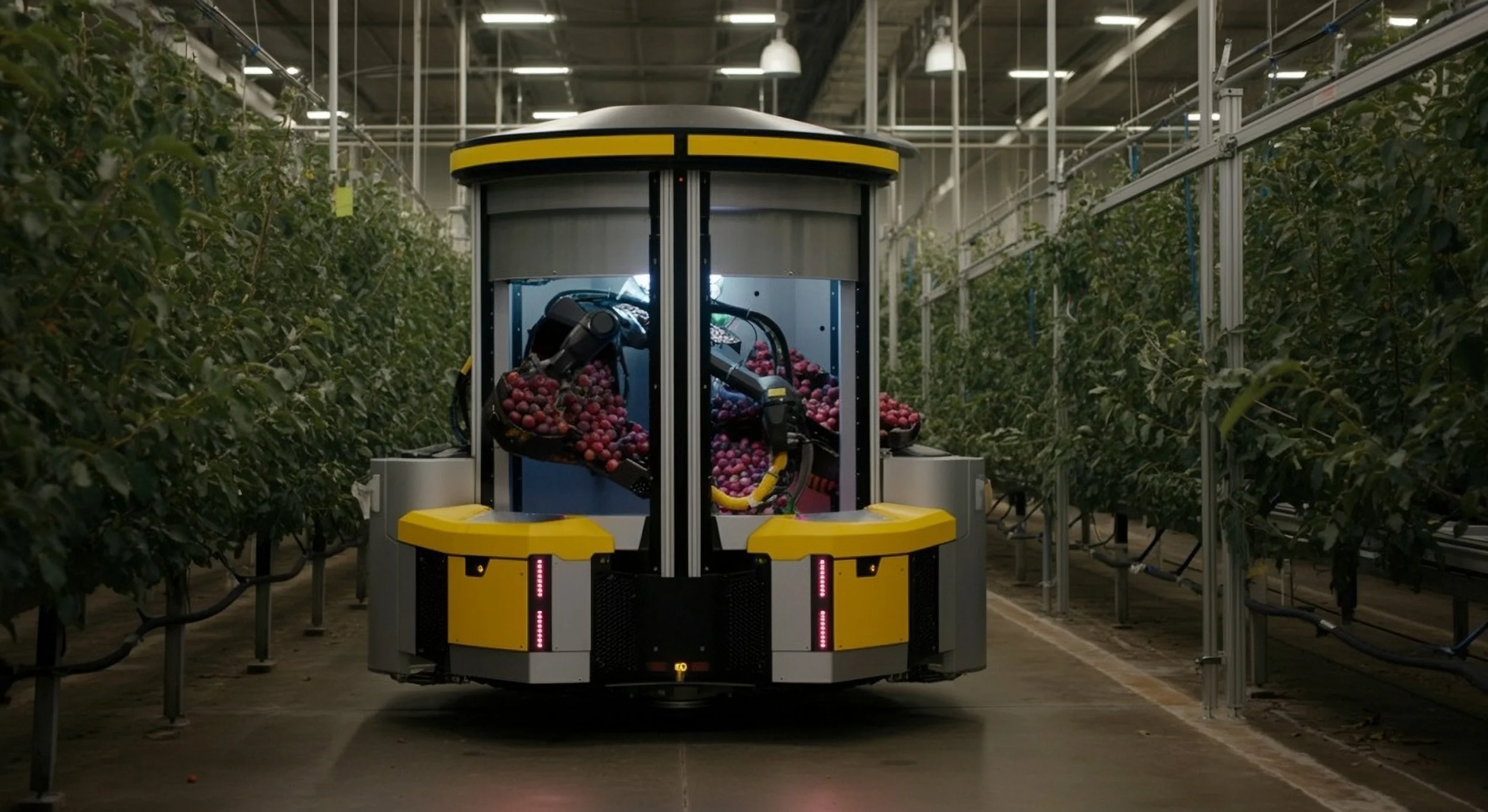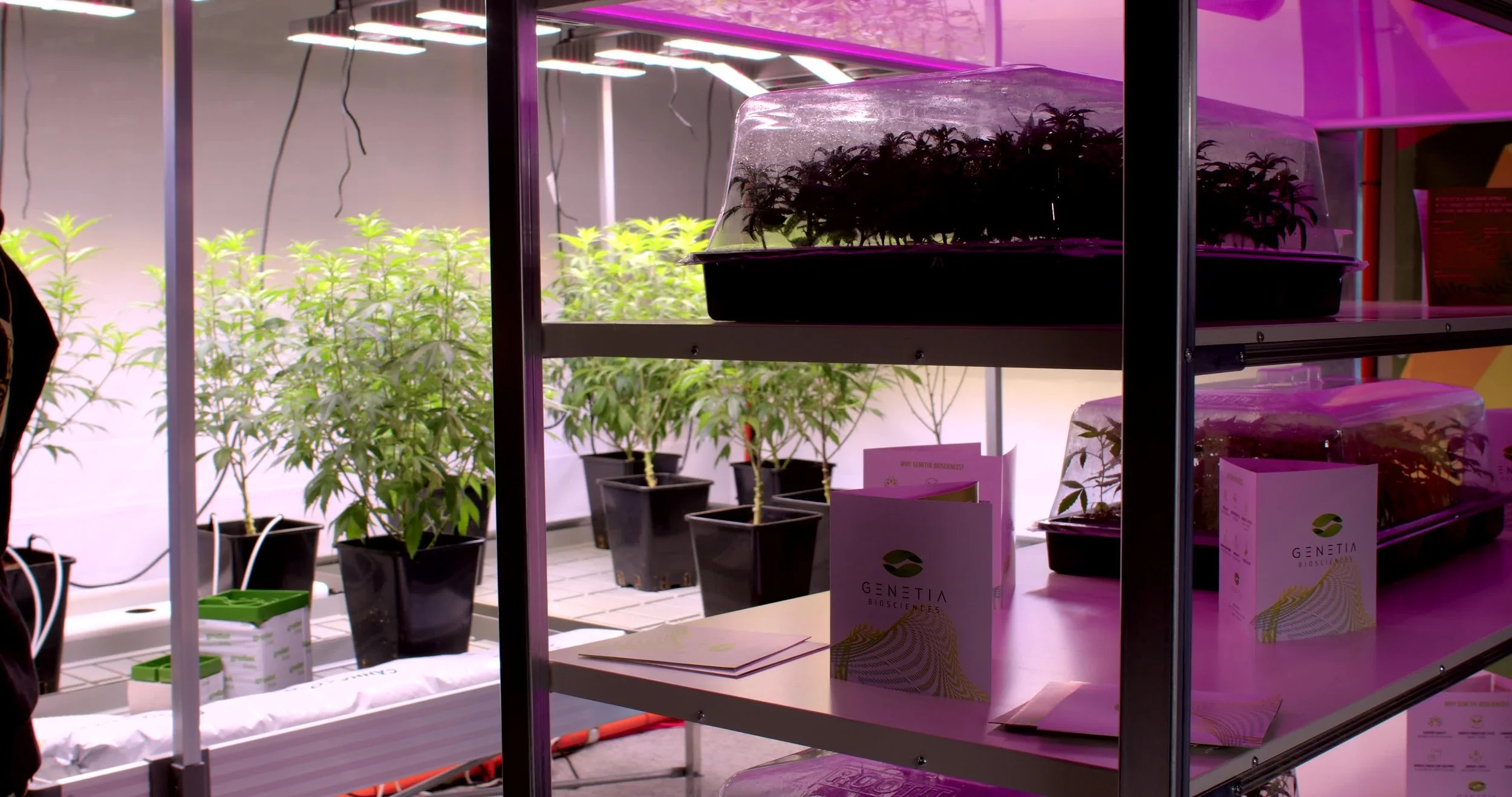Future Trends in Cannabis Automation: What to Expect in 2025
The cannabis industry is rapidly transforming through automation. With advanced tools like AI, robotics, IoT, and blockchain, businesses are changing the way they grow, process, and sell products. These technologies not only make operations more efficient but also help companies reduce costs and remain compliant with regulations.
The effect is clearly visible in the current market forecast. According to Coherent Market Insights, the cannabis technology market is expected to grow from USD 5.15 billion in 2025 to USD 25.41 billion by 2032, showing a CAGR of 25.6%. Such rapid expansion shows how automation enhances productivity and redefines competitive dynamics in the sector.
This guide explores the future of cannabis automation in 2025: from smarter cultivation and retail innovations to compliance, sustainability, and the industry outlook beyond 2025.
Cannabis Automation Market Growth and Key Demand Drivers in 2025
As demand for cannabis products rises, businesses are turning to advanced technologies to streamline their operations and improve performance. By the end of 2025, the cannabis automation market is expected to experience significant growth. Companies are adopting tools like robotic arms, automated storage and retrieval systems (ASRS), and AI-powered inventory management solutions to manage large volumes of products with greater speed and accuracy.
Along with boosting productivity, automation also helps businesses reduce operational costs. With machines handling repetitive and precise tasks, companies can more effectively scale their operations and meet market demand.
Embracing automation gives businesses a competitive edge by ensuring consistent quality, improving traceability, and maintaining product safety. As the industry continues to grow, automation will remain a key factor in shaping the future of cannabis production and distribution.
Top Drivers of Cannabis Automation Market Growth
From following the regulations to providing consistent products, there are several important reasons why businesses are adopting cannabis automation in 2025.
Legalization & Regulation
More states and countries are allowing cannabis for medical and recreational use. With each new market, the rules become tougher, including tracking plants from seed to sale, testing products, and reporting. Automation helps businesses follow these rules quickly and accurately.Labor Costs and Efficiency Pressure
Growing and processing cannabis manually requires a lot of work and can lead to mistakes. Automation helps businesses save time, reduce errors, and handle processes faster, helping them stay competitive in the market.Quality and Consistency Expectations
Consumers expect cannabis products to be safe, consistent, and reliable every time they purchase them. Automation helps businesses grow plants under controlled conditions, package them carefully, and label products accurately, ensuring that both customer expectations and regulatory standards are fully met.Scalability of Operations
As cannabis businesses scale through robotics automation, manual processes can become difficult and time-consuming. Automation allows companies to handle larger production volumes, manage inventory efficiently, and distribute products reliably, all while keeping quality high and minimizing the risk of mistakes. This makes it easier for businesses to expand without worrying about errors or delays.
Key Automation Technologies Shaping the Cannabis Industry
The demand for automation technology is increasing daily as cultivators, dispensaries, and distributors adopt these systems to save time, reduce errors, and improve operational efficiency. These technologies give businesses the insights and control they need to make smarter decisions at every stage.
Here are the key technologies driving automation in the cannabis industry and how they are shaping modern operations.
Smart Cultivation Systems (AI, Sensors, IoT)
Modern cannabis cultivation increasingly uses smart systems that monitor and control environmental conditions in real time. These systems track light, temperature, humidity, CO₂ levels, and soil moisture to make sure plants get exactly what they need.
Using IoT sensors and AI algorithms, growers can quickly respond to changes, such as adjusting ventilation if humidity gets too high or optimizing watering and nutrient schedules based on growth patterns. This technology helps maximize yields, reduce waste, and maintain consistent quality, even in large-scale operations.
Robotics for Harvesting, Trimming, and Packaging
Post-harvest tasks like trimming, harvesting, and packaging are labor-intensive and can lead to mistakes if done manually. Modern robotics automated systems can achieve trimming precision of cannabis with minimal damage to trichomes, ensuring product quality and consistency.
Automated Inventory and Seed-to-Sale Tracking
Cannabis businesses must follow strict regulations, and automated systems make compliance easier. Using RFID tags, barcodes, blockchain, or specialized software, every plant can be tracked from seed to final sale. These systems maintain accurate records, ensure consistent quality, reduce the risk of theft, and improve efficiency by minimizing manual work and errors.
For example, Illinois requires cannabis businesses to use RFID tracking through the METRC system for all plants and products.
AI and Data Analytics for Yield Prediction
AI-driven data analytics are changing the way cannabis growers plan and manage their crops. By analyzing historical growth data, environmental conditions, and strain genetics, these models can predict future yields with high accuracy, detect pests, diseases, or nutrient deficiencies early, and suggest optimized feeding and nutrient schedules.
This technology helps growers maximize crop output, reduce waste, save resources, and improve overall profitability, making operations more efficient and sustainable.
Do staff need special training to operate AI, robotics, or IoT systems?
Yes. Employees need some training to operate and manage automated systems effectively. This includes learning how to handle robotics, monitor AI-driven analytics, calibrate sensors, and troubleshoot common issues. Many businesses provide hands-on training or partner with technology providers to make sure staff can use the systems efficiently and safely.
How Automation Can Boost Your Cannabis Operations
As cannabis businesses face growing demand and tighter regulations, automation is becoming essential for smooth operations. These technologies streamline processes, reduce human error, and provide actionable insights, allowing companies to focus on growth and quality while keeping operations efficient and reliable.
Here are some key benefits of automation that are reshaping the cannabis industry and driving efficiency, quality, and compliance.
Cost Reduction and Operational Efficiency
Automation helps cannabis businesses save money and work more efficiently by taking over repetitive, time-consuming tasks like trimming, drying, and packaging. Machines can perform these jobs faster and more accurately than humans, which reduces mistakes, waste, and product loss.
This improves overall efficiency and gives a strong return on investment (ROI) and pilot planning for cannabis automation, letting companies grow production without hiring many extra workers. Meanwhile, staff can focus on important tasks that need attention to quality and strategy.
Improved Product Quality and Consistency
Automation ensures that every cannabis plant grows under the right conditions, including proper light, temperature, humidity, and nutrients. Robots and automated systems handle trimming and processing with high precision, protecting delicate parts of the plant and maintaining consistent cannabinoid levels.
This means each batch looks, tastes, and performs the same, building trust with customers. By reducing mistakes that happen with manual work, automation helps businesses deliver reliable, high-quality products every time.
Compliance and Regulatory Advantages
Automation makes it easier for cannabis businesses to follow the rules. Digital systems track every plant from seed to sale, automatically creating logs of cultivation, processing, and distribution. This reduces mistakes and ensures accurate reporting.
With better traceability, audits and inspections become simpler, helping companies meet strict local and federal regulations. Automation allows businesses to stay compliant without slowing down production, avoiding fines and showing accountability to regulators and customers alike.
Enhanced Worker Safety
Working in cannabis operations often involves repetitive or physically demanding tasks, like trimming flowers, lifting heavy trays, or checking machines, which can lead to injuries or long-term strain. Automation and robotics handle these tasks, making the workplace safer for employees.
This allows workers to focus on important activities like monitoring quality and managing operations, creating a safer, more productive, and comfortable working environment.
Data-Driven Decision Making
Automation systems gather real-time data on plant growth, environmental conditions, and operations. This information enables businesses to make informed decisions, optimize yields, manage resources more effectively, and plan production efficiently.
By spotting issues early, companies can reduce waste and improve overall processes. Using data in this way gives cannabis businesses a competitive edge in a fast-growing, highly regulated industry.
Scalability and Flexibility
Automation allows cannabis businesses to expand easily and efficiently. Growing more plants, introducing new strains, or boosting production becomes simpler without adding lots of extra staff. Automated systems keep quality and compliance consistent while letting companies adapt quickly to market changes or new regulations. This makes scaling operations smoother, faster, and more reliable, giving businesses the flexibility to grow confidently.
Energy and Resource Optimization
Automation helps cannabis businesses use energy and resources more efficiently. Smart systems adjust lighting, temperature, humidity, and water or nutrient use in real time, preventing waste and overuse. This lowers utility costs, improves profitability, and supports more sustainable operations with less impact on the environment.
Enhanced Supply Chain Management
Automation makes managing inventory, seed-to-sale tracking, and order fulfillment easier and more accurate. Businesses can monitor every product, reduce losses, prevent stock shortages, and ensure orders are delivered on time. This improves reliability, keeps customers satisfied, and helps maintain compliance with regulations.
Will automation replace human workers?
Automation can’t fully replace human workers, but it may reduce the number of employees needed. Since robots and automated systems handle many repetitive tasks, businesses can operate with fewer staff, lowering labor costs while still maintaining the operations.
How often do robots need maintenance?
Robots need regular maintenance to keep working efficiently, usually based on their usage and manufacturer recommendations. Routine checks, cleaning, lubrication, and software updates help prevent breakdowns and minimize downtime, ensuring smooth operations.
What Challenges Do Cannabis Businesses Face with Automation
While automation brings many advantages, businesses also face challenges when implementing these technologies. Understanding these barriers is essential to planning smarter and getting the most value from automation.
Here are the main barriers that cannabis businesses can encounter and ways to overcome them effectively.
High Capital Investment
Cannabis automation can be costly at the start, with robots, AI systems, and sensors requiring a big upfront investment. Smaller or new growers might find it hard to afford. Taking a step-by-step approach and focusing on the most important areas first can make it easier to manage costs while still boosting performance.
Regulatory Complexity & Legal Differences
Cannabis rules differ from place to place, and some areas limit or ban certain automation technologies. Businesses need to follow local, state, and federal laws, which can slow adoption. Using flexible systems and getting legal advice helps companies stay compliant while still benefiting from automation.
Skill Gaps & Workforce Training
Cannabis automation needs workers with specialized skills, like operating robots, maintaining equipment, calibrating sensors, and analyzing data. Without trained staff, businesses may struggle to use these systems effectively. Investing in training, hiring experts, or working with tech partners helps ensure automation works properly and delivers the expected benefits.
Data Security & Cyber Risks
Cannabis automation systems handle a lot of sensitive data, like cultivation records, seed-to-sale tracking, and compliance reports. These systems can be at risk of cyberattacks or failures, which could disrupt operations and cause regulatory problems. Strong practices in cannabis compliance and risk management are essential, along with cybersecurity measures like encryption, secure cloud storage, and regular audits, to keep data safe and operations running smoothly.
Technology Integration and Compatibility
New automation tools can be tricky to integrate with existing cultivation, processing, and inventory systems. Older equipment or manual processes may not work well with modern robotics or AI platforms. Companies often struggle to connect devices, sync data, and keep workflows running smoothly, which can slow adoption and increase costs.
Maintenance and Downtime
Automated systems need regular maintenance and occasional repairs. Downtime can disrupt production, affecting yields and delivery schedules. Companies must plan preventive maintenance, keep backup systems ready, and train staff to troubleshoot issues to keep operations running smoothly.
Resistance to Change
Some growers and employees may resist switching from traditional manual methods to automated systems. Worries about job security, learning new technologies, or distrust of AI-driven processes can slow adoption. Companies can overcome this by providing training, clearly explaining the benefits, and gradually introducing automation to build confidence and acceptance.
Limited Vendor Support and Service
Smaller growers may face challenges accessing reliable support, spare parts, or updates for automation solutions, which are often provided by specialized vendors. Choosing trusted suppliers, securing service contracts, and ensuring strong technical support help prevent disruptions and ensure systems perform efficiently, maximizing ROI.
How secure is the data collected by AI and IoT systems?
Data collected by AI and IoT systems is sensitive, including cultivating and maintaining legal documentation. Businesses protect it with encryption, secure cloud storage, and regular audits to prevent breaches and keep operations safe.
Top Cannabis Automation Trends to Watch in 2025
Despite these challenges, innovative technologies continue to emerge. As the cannabis industry grows and demand for medical cannabis increases, automation is taking the lead in 2025. From AI-powered cultivation to smart greenhouses, blockchain tracking, and innovative retail solutions, these technologies are reshaping how businesses grow, manage, and deliver cannabis.
The following trends highlight the key innovations of 2025 that are making operations more efficient, reliable, and sustainable.
AI-Powered Cultivation and Predictive Analytics
Growers are now using machine learning to forecast yields, fine-tune nutrient schedules, and spot pests or diseases early. These AI-powered insights help save resources, reduce waste, and ensure more reliable, consistent production.
Blockchain for Supply Chain Transparency
Blockchain technology lets businesses track every plant securely from cultivation to sale. This builds consumer trust, makes audits easier, and helps companies stay compliant with regulations.
Smart Greenhouses & IoT Integration
Fully automated greenhouses use sensors and AI to control lighting, ventilation, nutrients, and pest management. This reduces labor, keeps plants healthy, and ensures optimal growth conditions.
Automated Dispensaries & Novel Delivery Methods
Automation is changing how people buy cannabis. Self-service dispensaries, vending-style setups, and even drones or autonomous vehicles in some areas make shopping faster and easier. These technologies help businesses run more smoothly while giving customers a convenient and reliable experience.
Rapid Growth of Industry Software
Software solutions for audit, tracking, POS, and ERP systems are growing quickly. They help cannabis businesses manage daily operations, stay on top of regulations, and keep track of inventory more easily, making overall management smoother and more efficient.
Sustainability and Energy Optimization
Automation helps cannabis growers use energy, water, and nutrients more efficiently. By leveraging AI and IoT, systems adjust resource use in real time, reducing waste, cutting costs, and supporting more environmentally friendly operations.
Remote Monitoring and Cloud-Based Management
Modern automation systems let growers monitor and control their operations remotely through cloud-based dashboards or mobile apps. This gives them real-time insights, allows quick responses to any issues, and helps manage the entire cultivation process more efficiently and effectively.
These trends demonstrate how automation is transforming every aspect of cannabis production, from cultivation to retail, setting the stage for future growth and innovation.
Transform your Cannabis Business with State-of-the-Art Automation
Automation is reshaping the cannabis industry, from AI-driven cultivation and smart greenhouses to robotic harvesting and automated inventory tracking. These technologies not only improve efficiency and quality but also help businesses stay compliant and manage resources better.
To stay competitive in 2025 and beyond with Sorting Robotics’ cannabis automation solutions. Whether you need smart cultivation tools, reliable inventory management, or complete automation support, with these products you can simplify your processes, cut down errors, and help your business grow with confidence.
Frequently Asked Questions
Is automation a good or bad thing?
Automation is a tool that helps cannabis businesses work smarter, cut errors, and save resources, but it doesn’t replace the need for skilled human oversight.
What trends in cannabis automation are expected beyond 2025?
Beyond 2025, cannabis automation will use advanced AI, predictive analytics, and fully autonomous systems to optimize plant growth, manage supply chains, and improve efficiency, reliability, and sustainability.
What is the potential of the cannabis market?
The cannabis market is projected to reach US$83.56bn by 2030. This growth is driven by increased legalization, expanding medical and recreational use, and advancements in automation and technology. Automation is expected to play a significant role in enhancing efficiency and meeting the rising demand.
Can small cannabis businesses benefit from automation, or is it only for large operations?
Yes, small cannabis businesses can benefit from automation by focusing on key tasks like cultivation, monitoring, and seed-to-sale tracking without hiring extra staff.
How does automation improve cannabis product quality?
Automation controls growing conditions and uses robotics for precise trimming, ensuring consistent quality, potency, and appearance in every batch.



